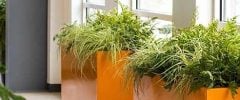3 Quick Fertilizing Tips to Keep Interiorscape Plants Thriving

People often ask me how to save struggling plants—a common challenge for anyone in the interiorscape industry. While plant health depends on many factors, proper fertilization is a crucial but frequently misunderstood aspect of keeping greenery vibrant and long-lasting. One of the biggest misconceptions is the assumption that the more you fertilize, the healthier your plants will be. However, over-fertilizing and excessive watering tend to be the most common mistakes in plant care, especially in commercial settings where maintenance may not always align with a plant’s specific needs. So, how can you avoid fertilization mistakes and maintain long-term plant health in your clients’ spaces?
Keep Plantscapes Healthy With a Fertilizing Schedule
It often surprises people to learn that most indoor plants only require fertilization once per quarter to maintain healthy growth. This is especially true when using chemical products, like most big-name brands—overuse can do far more harm than good. Unlike outdoor plants that benefit from long hours of natural sunlight, indoor plants receive much less light for photosynthesis. Slower photosynthesis means plants need fewer nutrients.
While I follow a quarterly fertilization schedule for most accounts, there are exceptions where plants in certain locations need nutrients more frequently. For example, plants in areas with strong natural light—such as car dealerships with large showroom windows, atriums with skylights, or high-rise buildings that receive sunlight all day—need fertilization more than four times a year. In these areas, pale foliage is usually my first clue that a plant isn’t getting enough nutrients to maintain its normal color. Plant location plays a major role in determining fertilization needs, and it’s crucial to plants’ longevity to consider their environment when planning a fertilization schedule.
Choose the Best Fertilization Method
As mentioned before, most well-known fertilizer brands are a combination of chemical nutrients that can cause chemical burns with overuse. Whether powder or liquid, they’re easy to add directly into a watering can, making it tempting to fertilize too often. The owner of the first interiorscape company I worked for had a unique approach—he added liquid fertilizer to the water before every use. While I never noticed chemical burns with his method, excessive fertilization can still lead to long-term issues. Personally, I didn’t enjoy going through that extra step every time I refilled.
When you have large areas to cover—especially atriums with multiple plant beds—hand-watering fertilizer is a very time-consuming task. In these spaces, I prefer slow-release granules like Osmocote. However, simply sprinkling the granules on the soil’s surface won’t benefit the plants much. You must blend the granules into the soil where the roots can access the nutrients. Although this is also a time killer, the slow release lasts six months or more, reducing the need to fertilize by half.
If you’re not great at accurately measuring fertilizer, organic or all-natural brands are a safer bet. Overapplication won’t result in a chemical burn, but the downside is cost. Natural fertilizers are usually more expensive, and when feeding hundreds of plants four or more times a year, that expense adds up.
Refresh Soil to Revitalize Interiorscape Greenery and Boost Growth
The addition of fresh potting soil is another fertilizing method I’ve found helpful, especially for older plants. Some of my accounts have plants that are over twenty years old—living relics that clients have become attached to. When these plants start to decline, the first thing I check is the soil. Typically, I find compacted, sandy-colored dirt with little to no nutrients left. After two decades, the soil is completely depleted. Because these older plants are sentimental to my clients, I take the time to either mix in high-quality potting soil or completely repot them. Shortly after, new growth typically emerges with a vibrant color—a clear sign that refreshed soil can make all the difference.
Healthy Soil, Thriving Plantscapes
Unlike outdoor plants that can spread their roots in search of new nutrients, potted foliage relies entirely on the care you provide. That’s why taking on the role of Mother Nature to create the right soil environment is essential. By understanding fertilization schedules and maintaining soil health, you can keep your installations vibrant and healthy for years to come—reducing replacements and ensuring client satisfaction.
You May Also Like
Leave a Reply
You must be logged in to post a comment.




















